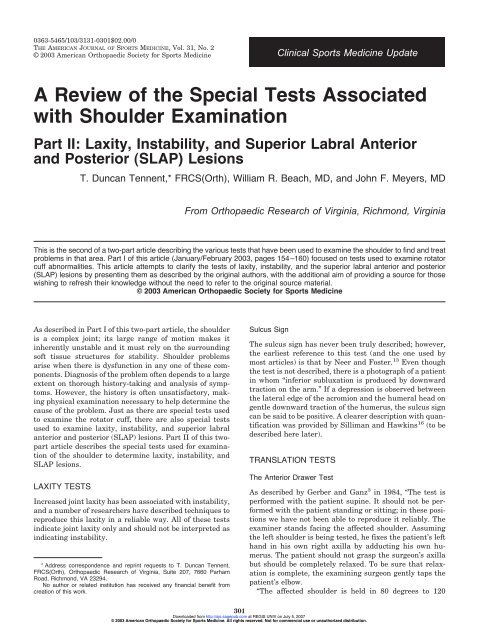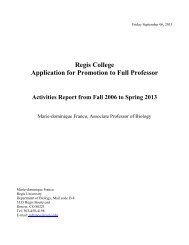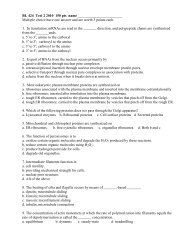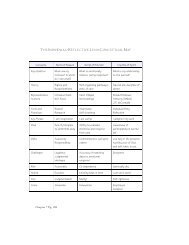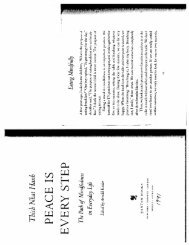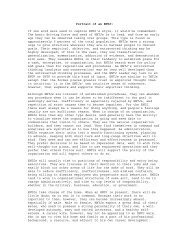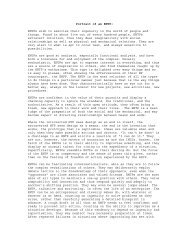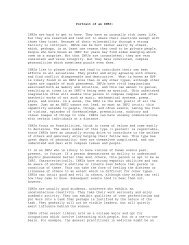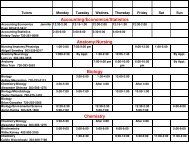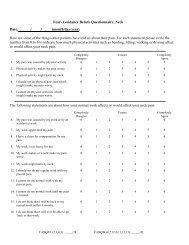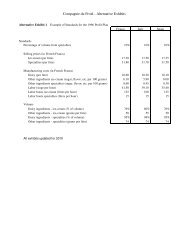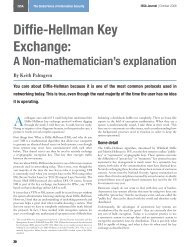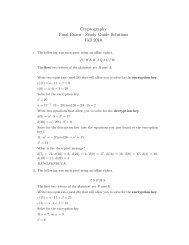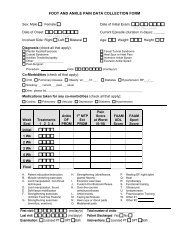Medicine American Journal of Sports
Medicine American Journal of Sports
Medicine American Journal of Sports
You also want an ePaper? Increase the reach of your titles
YUMPU automatically turns print PDFs into web optimized ePapers that Google loves.
0363-5465/103/3131-0301$02.00/0<br />
THE AMERICAN JOURNAL OF SPORTS MEDICINE, Vol. 31, No. 2<br />
© 2003 <strong>American</strong> Orthopaedic Society for <strong>Sports</strong> <strong>Medicine</strong><br />
A Review <strong>of</strong> the Special Tests Associated<br />
with Shoulder Examination<br />
Part II: Laxity, Instability, and Superior Labral Anterior<br />
and Posterior (SLAP) Lesions<br />
T. Duncan Tennent,* FRCS(Orth), William R. Beach, MD, and John F. Meyers, MD<br />
From Orthopaedic Research <strong>of</strong> Virginia, Richmond, Virginia<br />
This is the second <strong>of</strong> a two-part article describing the various tests that have been used to examine the shoulder to find and treat<br />
problems in that area. Part I <strong>of</strong> this article (January/February 2003, pages 154–160) focused on tests used to examine rotator<br />
cuff abnormalities. This article attempts to clarify the tests <strong>of</strong> laxity, instability, and the superior labral anterior and posterior<br />
(SLAP) lesions by presenting them as described by the original authors, with the additional aim <strong>of</strong> providing a source for those<br />
wishing to refresh their knowledge without the need to refer to the original source material.<br />
© 2003 <strong>American</strong> Orthopaedic Society for <strong>Sports</strong> <strong>Medicine</strong><br />
As described in Part I <strong>of</strong> this two-part article, the shoulder<br />
is a complex joint; its large range <strong>of</strong> motion makes it<br />
inherently unstable and it must rely on the surrounding<br />
s<strong>of</strong>t tissue structures for stability. Shoulder problems<br />
arise when there is dysfunction in any one <strong>of</strong> these components.<br />
Diagnosis <strong>of</strong> the problem <strong>of</strong>ten depends to a large<br />
extent on thorough history-taking and analysis <strong>of</strong> symptoms.<br />
However, the history is <strong>of</strong>ten unsatisfactory, making<br />
physical examination necessary to help determine the<br />
cause <strong>of</strong> the problem. Just as there are special tests used<br />
to examine the rotator cuff, there are also special tests<br />
used to examine laxity, instability, and superior labral<br />
anterior and posterior (SLAP) lesions. Part II <strong>of</strong> this twopart<br />
article describes the special tests used for examination<br />
<strong>of</strong> the shoulder to determine laxity, instability, and<br />
SLAP lesions.<br />
LAXITY TESTS<br />
Increased joint laxity has been associated with instability,<br />
and a number <strong>of</strong> researchers have described techniques to<br />
reproduce this laxity in a reliable way. All <strong>of</strong> these tests<br />
indicate joint laxity only and should not be interpreted as<br />
indicating instability.<br />
* Address correspondence and reprint requests to T. Duncan Tennent,<br />
FRCS(Orth), Orthopaedic Research <strong>of</strong> Virginia, Suite 207, 7660 Parham<br />
Road, Richmond, VA 23294.<br />
No author or related institution has received any financial benefit from<br />
creation <strong>of</strong> this work.<br />
301<br />
Sulcus Sign<br />
Clinical <strong>Sports</strong> <strong>Medicine</strong> Update<br />
The sulcus sign has never been truly described; however,<br />
the earliest reference to this test (and the one used by<br />
most articles) is that by Neer and Foster. 13 Even though<br />
the test is not described, there is a photograph <strong>of</strong> a patient<br />
in whom “inferior subluxation is produced by downward<br />
traction on the arm.” If a depression is observed between<br />
the lateral edge <strong>of</strong> the acromion and the humeral head on<br />
gentle downward traction <strong>of</strong> the humerus, the sulcus sign<br />
can be said to be positive. A clearer description with quantification<br />
was provided by Silliman and Hawkins 16 (to be<br />
described here later).<br />
TRANSLATION TESTS<br />
The Anterior Drawer Test<br />
As described by Gerber and Ganz 3 in 1984, “The test is<br />
performed with the patient supine. It should not be performed<br />
with the patient standing or sitting; in these positions<br />
we have not been able to reproduce it reliably. The<br />
examiner stands facing the affected shoulder. Assuming<br />
the left shoulder is being tested, he fixes the patient’s left<br />
hand in his own right axilla by adducting his own humerus.<br />
The patient should not grasp the surgeon’s axilla<br />
but should be completely relaxed. To be sure that relaxation<br />
is complete, the examining surgeon gently taps the<br />
patient’s elbow.<br />
“The affected shoulder is held in 80 degrees to 120<br />
Downloaded from<br />
http://ajs.sagepub.com at REGIS UNIV on July 5, 2007<br />
© 2003 <strong>American</strong> Orthopaedic Society for <strong>Sports</strong> <strong>Medicine</strong>. All rights reserved. Not for commercial use or unauthorized distribution.


